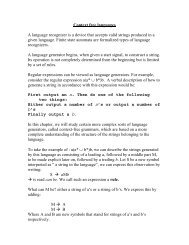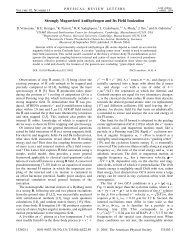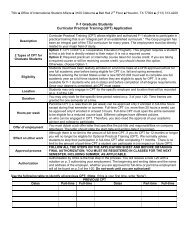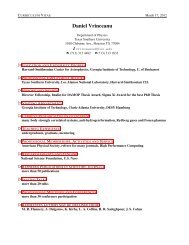You also want an ePaper? Increase the reach of your titles
YUMPU automatically turns print PDFs into web optimized ePapers that Google loves.
PHYSICAL REVIEW A 73, 022710 2006Long-range interactions between a He„2 3 S… atom and a He„2 3 P… atom for like isotopesJ.-Y. Zhang, 1 Z.-C. Yan, 1 D. Vrinceanu, 2 J. F. Babb, 3 and H. R. Sadeghpour 31 Department of <strong>Physics</strong>, University of New Brunswick, Fredericton, New Brunswick, Canada E3B 5A32 T-4 Group, Los Alamos National Laboratory, Los Alamos, New Mexico 87545, USA3 ITAMP, Harvard-Smithsonian Center for Astrophysics, Cambridge, Massachusetts 02138, USAReceived 20 September 2005; published 9 February 2006For the interactions between a He2 3 S atom and a He2 3 P atom for like isotopes, we report perturbationtheoretic calculations using accurate variational wave functions in Hylleraas coordinates of the coefficientsdetermining the potential energies at large internuclear separations. We evaluate the coefficient C 3 of the firstorder resonant dipole-dipole energy and the van der Waals coefficients C 6 , C 8 , and C 10 for the second orderenergies arising from the mutual perturbations of instantaneous electric dipole, quadrupole, and octupoleinteractions. We also evaluate the leading contribution to the third-order energy. We establish definitive valuesincluding treatment of the finite nuclear mass for the 3 He2 3 S- 3 He2 3 P and 4 He2 3 S- 4 He2 3 Pinteractions.DOI: 10.1103/PhysRevA.73.022710PACS numbers: 34.20.Cf, 31.15.Ar, 31.15.CtRecently, there has been considerable interest in the studyof helium dimers and ultracold helium collisions associatedwith metastable helium atoms 1–11. Molecular lines of thehelium dimers associated with the He2 3 S-He2 3 P asymptoteshave been produced by photoassociation ofspin-polarized metastable helium atoms He2 3 S 1 . In thepurely long-range 0 u + potential well with a minimum internucleardistance reaching 150 bohrs associated with theHe2 3 S 1 -He2 3 P 0 asymptote, bound states of the heliumdimer 1,2,5 can be used in measurements of the s-wavescattering length for collisions of two 4 He2 3 S 1 atoms 4,6.Molecular lines to the red of the D 2 atomic transition inhelium dimers associated with the He2 3 S-He2 3 P 2 asymptoteare of interest for control of the scattering lengthusing an “optical Feshbach resonance” 4,7. Published dataare scarce on the long-range part of the He2 3 S-He2 3 Ppotential energies, which determine the energy level structuresof the ultralong-range dimers formed in the photoassociationof ultracold metastable helium atoms.In this paper, we present perturbation theoretic calculationsof the coefficients determining the potential energies atlarge internuclear separations using accurate variationalwave functions in Hylleraas coordinates. We evaluate thecoefficient C 3 of the first order resonant dipole-dipole energy,and the van der Waals coefficients C 6 , C 8 , and C 10 of thesecond order energies arising from the mutual perturbationsof instantaneous electric dipole, quadrupole, and octupoleinteractions. We also evaluate for the third order energy thecoefficient C 9 of the leading term. We establish definitivevalues including treatment of the finite nuclear mass for the3 He2 3 S- 3 He2 3 P and 4 He2 3 S- 4 He2 3 P interactions.Definitive values for the C 6 , C 8 , C 9 , and C 10 coefficients areestablished.In this work, atomic units are used throughout. For theHe2 3 S-He2 3 P system, the zeroth-order wave functionappropriate for the perturbation calculation of the long-rangeinteraction can be written in the form 12, 0 M, ± = 1 2 na nb 1M; ± na nb 1M;,where na is the metastable He2 3 S wave function, nb isthe wave function for the He2 3 P atom with magneticquantum number M, and are the collection ofcoordinates of the two helium atoms in the laboratory referenceframe, and the “” sign indicates the gerade and ungeradestates. The corresponding zeroth-order energy is0E na n=E 0bna+E 0 nb. At large internuclear distances, the interactionpotential between the two helium atoms can be expandedas an infinite series in powers of 1/R 12where V = =0 L=0V LR +L+1 ,V L =4−1 L ,L −1/2 K L T T L − . 3T and T L − are the atomic multipole tensor operatorsdefined asT = Q i i Y ˆ i,4iandT L − = q j L j Y L− ˆ j,5jwhere Q i and q j are the charges on particles i and j. Thecoefficient K L isK L = + L + + L 1/2L + and ,L,...=2+12L+1¯ .1261050-2947/2006/732/0227105/$23.00022710-1©2006 The American Physical Society
ZHANG et al.First order. According to the perturbation theory, the firstorderenergy 12 can be written asV 1 =− C 3M, ±R 3 , 7whereC 3 0, ± =± 8 9 n a Q i i Y 1 ˆ i nb 1; 2 ,i8andC 3 ±1, ± = 4 9 n a Q i i Y 1 ˆ i nb 1; 2 .i9Second order. The second-order energy isV 2 =− 0 V ns L s M s ; nt L t M t ; 20,n s n t L s M s L t M tE ns n t− E na n b10where ns L s M s ; nt L t M t ; is one of the intermediatestates with the energy eigenvalue E ns n t=E 0 ns+E 0 nt, and theprime in the summation indicates that the terms with0E ns n t=E na nshould be excluded. Substituting 2 into 10,bwe obtainV 2 =−n s n t L s M sB 1 ± B 20, 11L t M tE ns n t− E na n bwithB 1 = na nb 1M;V ns L s M s ; nt L t M t ; 2 ,12andB 2 = na nb 1M;V ns L s M s ; nt L t M t ; na nb 1M;V ns L s M s ; nt L t M t ;.13B 2 in 13 is the exchange interaction of the two statesHe2 3 S and He2 3 P. After applying the Wigner-Eckarttheorem, we havewithB 1C0=n s n t L s M s L t M tE ns1 L,L,L s ,L t ,M,n t− E na n b LLL s L tR 2L s +L+L+214C 1 L,L,L s ,L t ,M = 12 G 1L,L,L s ,L t ,MF 1 L,L,L s ,L t .15In 15, G 1 is the angular-momentum part and F 1 is theoscillator strength part. Their expressions areG 1 L,L,L s ,L t ,M = −1 L+L L,L 1/2 −M K s −MLs L K sLs LM s M tandF 1 L,L,L s ,L t 1 L L t− M M s M t 1 L L t− M M s M t,16= 3 ḡ n s ;n a n aL s ,0,0,L s ,L s ḡ nt ;n b n bL t ,1,1,L,L,2 n s n tE ns n a+ E nt n bE ns n aE nt n b17withḡ ns ;n a n bL s ,L 1 ,L 2 ,,= 8 E ns n aE ns n b, 2L1 +12L 2 +1 na L 1 ; Q i i Y ˆ i ns L s ;i nb L 2 ; Q i i Y ˆ i ns L s ;,i18and E ns n a=E 0 ns−E 0 na, etc. For the special case when the twoinitial states na and nb are the same and =, ḡ ns ;n a n areduces to the absolute value of the 2 -pole oscillatorstrength8Ens nf¯ns n =aa 2 +1 2 2L 1 +1 na L 1 ; Q i i Y ˆ i ns L s ; 2 .i19Similarly, we haveB 2C0=n s n t L s M s L t M tE ns2 L,L,L s ,L t ,M,n t− E na n b LLL s L tR L s +L t +L+L+220C 2 L,L,L s ,L t ,M = 12 G 2L,L,L s ,L t ,MF 2 L,L,L s ,L t ,withG 2 L,L,L s ,L t ,MPHYSICAL REVIEW A 73, 022710 2006= −1 L+Ls L,L 1/2 −1 M s +M −M tK s MLs L K tL L tM s M t21 1 L L t− M M s M t 1 L L s− M M t M s, 22022710-2
ZHANG et al.TABLE II. Contributions to C 6 M ,±, in atomic units for the He2 3 S- He2 3 P system from 3 P, 3 S, ( 3 P,pp 3 P), and 3 P, 3 D symmetries.Symmetries C 6 0,± C 6 ±1, ± 3 P, 3 S 684.0919692 171.02299191( 3 P,pp 3 P) 1.316489322 3.291223293 3 P, 3 D 1954.8252484 1688.2581683PHYSICAL REVIEW A 73, 022710 2006H =− 1 22 r1− 1 2e 2 r2− 1 r1 · r2 + q nq e+ q nq ee m n r 1 r 2+ q 2e,r 1239where r 12 =r 1 −r 2 and e =m e m n /m e +m n is the reducedmass between the electron and the nucleus. The eigenvaluespectrum and corresponding eigenfunctions are obtained bydiagonalizing the Hamiltonian 39 in the correlated Hylleraasbasis set 12H =− 1 22m Rn− 1 2n 2m R1− 1 2 q n q ee 2m R2+e R n − R 1 +2q n q eR n − R 2 + q eR 1 − R 2 ,35r i 1 r j 2 r k 12 e −r 1 −r 2Y LM 1 rˆ1,rˆ2, 402where Y LM 1 rˆ1,rˆ2 is the coupled spherical harmonics for the2two electrons forming a common eigenstate of L 2 and L z .Except for some truncations, all terms are included in thebasis such thatwhere m n and m e are the masses of the nucleus and electron,respectively, q n and q e are their charges, and R n , R 1 , and R 2are the corresponding position vectors relative to the laboratoryframe. We introduce the following transformation:i + j + k ,41with being an integer. As increases, the size of the basisset is increased progressively.It is necessary to transform the transition operator,r 1 = R 1 − R n ,36T = q n R n Y 0 Rˆ n + q e R 1 Y 0 Rˆ 1 + q e R 2 Y 0 Rˆ 2,42r 2 = R 2 − R n ,37into the center-of-mass coordinates 13. The transformed T with =1, 2, and 3 for the dipole, quadrupole, and octupolemoments for a neutral helium areX = 1 M Tm n R n + m e R 1 + m e R 2 ,382T 1 =− r j Y 10 rˆ j,j=143where M T =m n +2m e is the total mass of helium atom and Xis the position vector for the center of mass of helium. In thecenter-of-mass frame, the Hamiltonian becomesT 2 =−1−2 m e2M Tj=1r 2 j Y 20 rˆ j + 30 m er 1 r 2 rˆ1 rˆ2 2 M 0 ,T44TABLE III. C 3 M ,±, C 6 M ,±, C 8 M ,±, C 9 M ,±, and C 10 M ,±, in atomic units, for theHe2 3 S-He2 3 P system.Mass He- He4 He- 4 He3 He- 3 HeC 3 0,± ±12.81549310754 ±12.81817512054 ±12.81905260194C 3 ±1, ± 6.40774655362 6.40908756032 6.40952630112C 6 0,± 2640.23381 2641.50832 2641.92553C 6 ±1, ± 1862.57241 1863.47262 1863.76744C 8 0,+ 311901.24 311955.45 311972.81C 8 0,− 15419932 15423521 15424701C 8 ±1, + 168906.54 168921.63 168926.52C 8 ±1,− 103017.33 103039.54 103046.73C 9 0,± ±512059.2276 ±512572.3436 ±512740.3186C 9 ±1, ± 117073.5362 117199.2112 117240.3542C 10 0,+ 2.922482310 7 2.922304510 7 2.922244310 7C 10 0,− 1.857456310 8 1.8574503310 8 1.8574492310 8C 10 ±1, + 1.611301310 7 1.611325310 7 1.611334510 7C 10 ±1,− 2.40597310 6 2.40608110 6 2.40613210 6022710-4
LONG-RANGE INTERACTIONS BETWEEN A He2 3 S…PHYSICAL REVIEW A 73, 022710 2006TABLE IV. Comparison C 3 M ,± and C 6 M ,± for the 4 He2 3 S- 4 He2 3 P system.Author C 3 0,± C 3 ±1, ± C 6 0,± C 6 ±1, ±Venturi et al. 5 ±12.82044 6.41022 2620.76 1846.60Léonard et al. 2 ±12.8106 6.4053This work ±12.81817512054 6.40908756032 2641.50832 1863.472622M TT 3 =−1−3 m eM T+3 m e + 3 352 2 m eM T−3 m e2j=1r j 3 Y 30 rˆ jM T2r 2 1 r 2 rˆ1 rˆ1 2 3 rˆ2 0+ r 2 2 r 1 rˆ2 rˆ2 2 rˆ1 03. 45It is noted that for the case of infinite nuclear mass, the aboveoperators reduce to2T =− r j Y 0 rˆ j.j=146For the finite nuclear mass case, however, T cannot be obtainedby a simple mass scaling from T , except T 1 whichdoes not contain m e /M T explicitly for a neutral system.Table I gives the convergence pattern of C 6 M ,± for thecase of infinite nuclear mass as the sizes of the basis sets,including the two initial states and the four intermediatestates, increase progressively. Table II lists the contributionsto C 6 M ,± from three pairs of intermediate symmetries 3 P, 3 S, ( 3 P,pp 3 P) doubly excited states, and 3 P, 3 D.Our final results for C 3 M ,±, C 6 M ,±, C 8 M ,±,C 9 M ,±, and C 10 M ,± are presented in Table III. To ourknowledge, no definitive calculations have been reported forthe dispersion coefficients C 6 M ,±, C 8 M ,±, C 9 M ,±,and C 10 M ,±. Table IV is a comparison with the existingvalues of C 3 M ,± and C 6 M ,±. Our values for C 3 M ,±differ from those given in Refs. 2,5. The origins of thesediscrepancies are uncertain. Drake 14 tabulated the oscillatorstrengths of helium, including 3 He and 4 He. In order toextract the square of the transition matrix element connecting2 3 S and 2 3 P, besides some numerical constants, the tabulatedvalue should be multiplied by 1+2m e /m n and dividedby the transition energy corrected for the finite nuclear mass.Our results are in perfect agreement with the values obtainedby Drake. For C 6 M ,±, our values differ from the valuesused in the work of Venturi et al. 5 at the level of 0.8 and0.9%, respectively, for C 6 0,± and C 6 ±1, ±.We are grateful to Dr. Jim Mitroy for suggesting that thethird-order energy correction might contribute at order 1/R 9 .This work is supported by the Natural Sciences and EngineeringResearch Council of Canada, by the ACRL of theUniversity of New Brunswick, by the SHARCnet, and by theNSF through a grant for the Institute of Theoretical Atomic,Molecular and Optical <strong>Physics</strong> ITAMP at Harvard Universityand the Smithsonian Astrophysical Observatory.1 J. Léonard, M. Walhout, A. P. Mosk, T. Müller, M. Leduc,and C. Cohen-Tannoudji, Phys. Rev. Lett. 91, 0732032003.2 J. Léonard, A. P. Mosk, M. Walhout, P. van der Straten, M.Leduc, and C. Cohen-Tannoudji, Phys. Rev. A 69, 0327022004.3 J. Kim, U. D. Rapol, S. Moal, J. Léonard, M. Walhout, and M.Leduc, Eur. Phys. J. D 31, 227 2004.4 J. C. J. Koelemeij and M. Leduc, Eur. Phys. J. D 31, 2632004.5 V. Venturi, P. J. Leo, E. Tiesinga, C. J. Williams, and I. B.Whittingham, Phys. Rev. A 68, 022706 2003.6 J. Kim, S. Moal, M. Portier, J. Dugué, M. Leduc, and C.Cohen-Tannoudji, Europhys. Lett. 72, 548 2005; S. Moal,M. Portier, J. Kim, J. Dugué, M. Leduc, and C. Cohen-Tannoudji, e-print cond-mat/0509286.7 J. Léonard, A. P. Mosk, M. Walhout, M. Leduc, M. vanRijnbach, D. Nehari, and P. van der Straten, Europhys. Lett.70, 190 2005.8 D. Vrinceanu and H. R. Sadeghpour, Phys. Rev. A 65, 0627122002.9 D. Vrinceanu, S. Kotochigova, and H. R. Sadeghpour, Phys.Rev. A 69, 022714 2004.10 M. R. Flannery, D. Vrinceanu, and V. N. Ostrovsky, J. Phys. B38, S279 2005.11 K. Singer, J. Stanojevic, M. Weidemüller, and R. Côté, J. Phys.B 38, S295 2005.12 Z.-C. Yan, J. F. Babb, A. Dalgarno, and G. W. F. Drake, Phys.Rev. A 54, 2824 1996.13 J.-Y. Zhang and Z.-C. Yan, J. Phys. B 37, 723 2004.14 G. W. F. Drake, in Atomic, Molecular, and Optical <strong>Physics</strong>Handbook, edited by G. W. F. Drake AIP, New York, 1996.022710-5
















